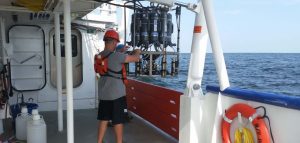June 1, 2017
On a trip to Louisiana earlier this spring, members of the Iowa County’s Farmer-Led Watershed Protection Group in southwestern Wisconsin learned more about hypoxia – commonly referred to as the “dead zone” – in the Gulf of Mexico.

A scientist from the Louisiana Universities Marine Consortium deploys a water sensor to collect samples for testing oxygen levels in the Gulf of Mexico.
Farming practices in the Midwest have contributed to hypoxia when excess nutrients run off land into waterways that flow into the Mississippi River and ultimately the gulf. The Iowa County group is comprised of farmers who are doing their part to reduce nutrient loads. But the undertaking is huge, as the Iowa County farmers learned from people who earn their living from the gulf — and from researchers who have studied hypoxia for years.
Hypoxic waters contain dissolved-oxygen concentrations of less than 2 parts per million to 3 parts per million, according to the Mississippi River/Gulf of Mexico Task Force. Hypoxia can be caused by a variety of factors – including excess nutrients.
Excess nutrients stimulate an overgrowth of phytoplankton, said Nancy Rabalais, distinguished research professor of Louisiana Universities Marine Consortium DeFelice Marine Center in Chauvin, Louisiana, and a professor in Louisiana State University’s Department of Oceanography and Coastal Sciences. The decomposition of phytoplankton consumes oxygen and, in turn, oxygen is depleted for marine life.
The Mississippi River carries fresh water into the gulf, creating stratification where the lighter body of fresh water sits atop heavier saltwater. The stratification prevents oxygen from circulating to the gulf’s depths. Thus marine-life that can’t swim — like stone crabs and oysters – don’t have access to oxygen. They die.
Hypoxia is more prevalent during summer months when water is calm. Cold fronts and storms, which occur more frequently in fall and winter, churn water and circulate oxygen. Marine creatures then have more available oxygen.
Hypoxia was observed as early the 1970s when researchers from Louisiana State University and Nicholls State University mapped small areas of the dead zone. Testing of the Gulf of Mexico has taken place every year since 1985, Rabalais said.
In June 2016, scientists at the National Oceanic and Atmospheric Administration forecast that the dead zone in 2016 would be about 5,898 square miles – the size of Connecticut. The dead zone has averaged this size for the past several years, the administration added.
Researchers have found in sediment cores an increase in phytoplankton that indicate more of their production. The sediment cores show what has changed in the span of decades. The amount of protozoans tolerant to hypoxia accelerated from the 1950s onward while intolerant protozoans decreased. The numbers can be correlated to increased use of fertilizer, Rablais said.
She added that consortiums – such as Green Lands/Blue Waters – are promoting ways to reduce nutrient runoff. Green Lands/Blue Waters is a consortium of several universities in the Midwest as well as Louisiana State University, along with conservation groups and farmer organizations. The consortium supports the incorporation of more perennial plants and other cover crops on farms.
But, while efforts are effective, they’re still not conducted on a grand scale, Rabalais said.
Bill Northey, Iowa Secretary of Agriculture and co-chair of the Mississippi River/Gulf of Mexico Hypoxia Task Force, said, “Watershed efforts looking at water quality can be seen locally first. Then we must continue to build on that to see bigger impacts, especially at the Mississippi River-basin scale. I’m encouraged by the work being done and how engaged farmers are, but we always knew this would be a long-term process.”
Using agricultural innovations and finding new ways to help farmers do an even better job on the farm is how results will be seen, Northey said.
“This is how we’ve made progress to increase yields and reduce soil erosion, and it’s how we’ll see progress on water quality,” he said. “We’ve gone from several-hundred-thousand acres of no-till in the 1980s to about 6 million acres in the last census of agriculture. There are differences in the impact of each practice, but we need all practices to achieve our large goal.”
In Iowa there are 16 watershed-protection projects. Seven more projects in the state are focused on expanding the use and delivery of water-quality practices, while there are 34 urban water-quality demonstration projects.
“More than 150 organizations are participating in these projects.” Northey said. “Partners will provide $25.28 million with more than $16 million in state funding for these projects.”
In 2016 the Wisconsin Department of Agriculture, Trade and Consumer Protection awarded grants totaling more than $242,500 to 14 producer-led watershed-protection groups. The groups were able to use grant monies on projects that focus on ways to prevent and reduce runoff from farm fields, and to help increase farm participation. In 2017, the department is awarding more than $197,000 to 11 producer-led groups.
“Farmers in general recognize that what they do has an impact downstream and they care about being good stewards,” Northey said.
Farmers also discuss the benefits of watershed stewardship in their communities and on their farms.
“There’s a lot of work being done around the benefits of cover crops on soil health, which can increase crop productivity,” Northey said. “If we can show multiple benefits for the Gulf of Mexico all the way back to farms, even better.”
As Northey said, the work will be a long-term process. But as farmers generally understand – nothing worthwhile is easy.
Source: http://www.agupdate.com/agriview/news/crop/tackling-dead-zone-long-term-job/article_1014d447-7836-567d-b8af-cef47186fa66.html
